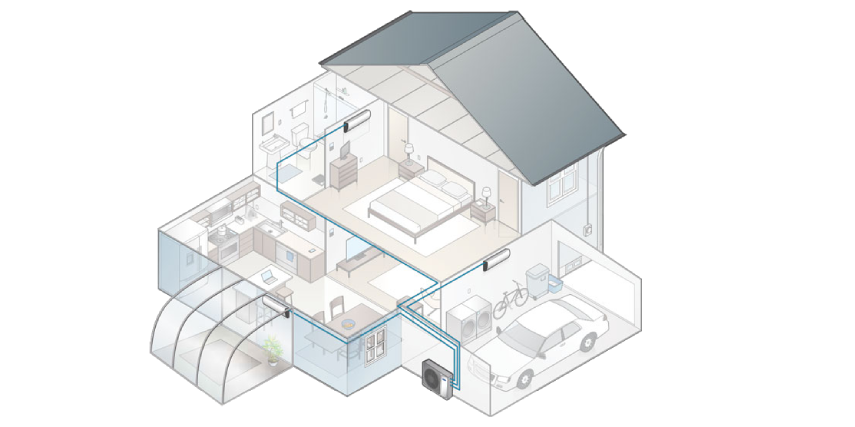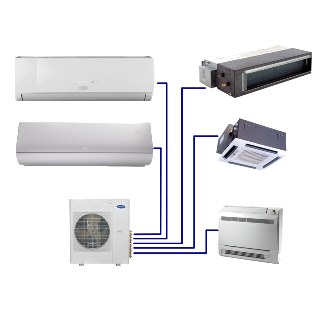The Advantages And Disadvantages Of Mini Split Systems


Are you on the search for an heating and air conditioning system that offers better comfort, lower energy bills, and more customization options than what you have now? Mini split systems could be the solution you’re looking for.
You may have heard them called split heat pump systems, ductless air conditioners, or mini split air conditioners. You may have also seen them in businesses. Ever notice a restaurant or someone’s home with a panel on the wall that circulates air? That unit is part of a mini split.
These systems have several advantages over traditional heating and cooling.
But, there are a few drawbacks to consider as well.
As a product manager at Peirce Phelps, I’ve worked closely with contractors in the mid-Atlantic region who have installed thousands of these systems. It’s given me a well-rounded view not only of how they work, but also about what features matter most to homeowners – and what aspects they don’t like.
I’m excited to share that expertise with readers who are interested in upgrading their heating and cooling. In this article, I’ll delve into the workings of mini split systems and explore their advantages and disadvantages.
I’ll also cover essential considerations like installation costs, maintenance requirements, and which spaces are best suited to these systems.
Whether you’re considering installing a mini split system or simply want to learn more about them, keep reading.
If you have more questions or want a free consultation for your home in Pennsylvania, Delaware, or New Jersey, click the Dealer Locator button to find a certified HVAC contractor near you.
How Mini Split Systems Work


Ductless mini split systems transfer heat from one area to another, either by removing heat from the air or by adding heat to the air. They consist of two main units: an outdoor compressor, or heat pump, and an indoor air handler. Each air handler heats or cools one room in the house. One heat pump can support up to eight air handlers.
These units connect through a conduit that houses electrical wires, drainage pipes, and refrigerant tubing. Since the system only moves warmth, not air, there’s no need for ductwork.
Instead, refrigerant liquid carries heat in a closed loop between the indoor and outdoor units.
Benefits of Mini Split Systems
Better Comfort
Mini split systems provide a more comfortable and consistent heating and cooling experience than traditional HVAC systems. Each air handler has a thermostat so that you can set the temperature in every room individually.
The heat pump is also much more precise with temperature control. It uses inverter technology to run at different speeds so each room is always within a degree of the thermostat setting.
Compare that to forced-air or other systems where temperatures can drift by up to 10 degrees.
Lower Energy Bills
One of the main benefits of mini split systems is that they are highly energy-efficient, which means save energy and can help homeowners save money on their energy bills in the long term.
That inverter technology also uses less energy than a furnace or central air needs to stop and start a few times every hour. Also, the heat pump doesn’t generate heat. It only has to transfer it from outside into your home.
That process, which doesn’t require fossil fuels for combustion, uses very little energy.
Customization
Mini split systems can be customized with multiple indoor units so you can control the temperature in different areas parts of the house. This is particularly beneficial for larger homes or homes with multiple floors. Or, use a single-zone setup with one air handler for the individual room that’s always too hot or cold.
Higher Home Value
Mini splits can increase the overall value of a property by $10,000 or more.
Disadvantages of Mini Split Systems
Expensive to Install
One of the main disadvantages of mini split systems is their high installation costs. A typical forced-air cooling and heating system plus installation costs $8,000 to $10,000 with installation. Mini splits start at $3,500 for a single zone, and the price can total more than $20,000 for the whole house.
However, you’ll make up that extra upfront cost over time with lower energy bills. Most homeowners make up that extra cost in five to seven years with the money they save each month.
More Maintenance
A mini split system requires spring and fall tune-ups just like a furnace and AC. But, you should also get a deep cleaning once a year to prevent mildew and mold from growing in the units.
Best for Open Spaces: Mini split systems are most effective in open spaces, where the air can circulate freely. One air handler can cover a lot of ground. But, a home with a lot of rooms requires more air handlers to cover them all.
Appearance: The indoor units of mini split systems can be unattractive, especially in smaller living spaces. Fortunately, there are plenty of ways to camouflage the air handlers or tuck them into out-of-the-way spaces.
Mini Split Installation and Maintenance
When it comes to installing a mini split system, it’s important to hire a professional installer who’s licensed and insured, and is certified to install it correctly.
While saving money with a DIY project is tempting, there are many risks involved.
An under- or -over-sized system won’t provide adequate heating and cooling. It’s also more likely to break down faster than normal. You also risk electrical problems, leaks, condensate drain clogs, and other issues from a bad install. Plus, you’ll void the warranty — manufacturers require a certified professional to do the job.
Mini splits can last 20 years or more with the proper care. Regular maintenance is essential to ensure that it operates effectively and efficiently. That includes cleaning the filters and having an HVAC tech inspect the system before the heating and cooling seasons.
Mini Split FAQs
I’m ending this article with a few more mini split FAQs. You can always get in touch with one of our certified dealers for a free consultation if you have specific questions about your home.
Do mini splits use a lot of electricity?
Mini split systems are extremely efficient and do not use a lot of electricity. Compared to conventional room air conditioners and gas or oil heaters, a ductless mini split heating and cooling system can cut energy costs by 30 percent.
What is the life expectancy of a mini split system?
The life expectancy of a mini split system is typically around 20 years or more, provided that it is properly installed and maintained. The right care will also help it maintain efficiency and performance.
Can a mini split cause a fire?
A mini split system can catch fire if it’s not properly maintained, but this is rare. Dirt and debris can accumulate in the vents, coils, and air filters. These obstructions prevent proper airflow, which can choke the unit. Regular cleaning prevents it from becoming a fire hazard.
Do mini splits work in extreme heat?
Mini splits can work in extreme heat up to 115 degrees Fahrenheit. But, they may have to work harder than normal and use more energy to maintain the indoor temperature. Since mini splits are heat pumps, they operate similarly to air conditioners but can also switch to heating mode.
Do mini splits work in extreme cold?
Mini splits can work in extreme cold down to -15 degrees Fahrenheit. However, their efficiency may decrease as the temperature drops. They’ll struggle to maintain the indoor temp when the outside temperature gets below the system’s maximum cold temp.
A mini split for your Philadelphia, PA home can enhance your comfort and lower energy bills. Find out how we can help.